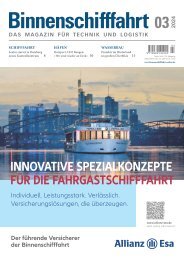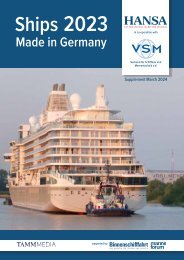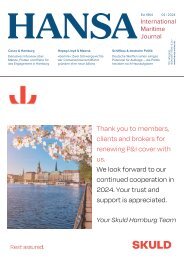HANSA 10-2023
MSC-Einstieg bei HHLA · Niedersachsens Häfen · HullPIC 2023 · Peter Gast Schiffahrtsregatta · Offshore-Marktkompass · VDMA · NMK · London Shipping Week · Methanol-Neubau für Maersk
MSC-Einstieg bei HHLA · Niedersachsens Häfen · HullPIC 2023 · Peter Gast Schiffahrtsregatta · Offshore-Marktkompass · VDMA · NMK · London Shipping Week · Methanol-Neubau für Maersk
Sie wollen auch ein ePaper? Erhöhen Sie die Reichweite Ihrer Titel.
YUMPU macht aus Druck-PDFs automatisch weboptimierte ePaper, die Google liebt.
SCHIFFSTECHNIK | SHIP TECHNOLOGY<br />
sources of uncertainty, higher than most<br />
of us have believed. A study from JoRes<br />
and MARIN on these uncertainties was<br />
presented by Dmitriy Ponkratov during<br />
the event. The result of this study was that<br />
sea trials usually come with an uncertainty<br />
of 4-6 %. This lack of accuracy and certainty<br />
remains a challenge for performance<br />
analytics. It also is a challenge when<br />
assessing new technologies like wind assisted<br />
propulsion. Luckily, an ITTC committee<br />
is working on recommended procedures<br />
for performance indicators in<br />
this sector to enable a fair comparison<br />
and facilitate the investment decisions.<br />
The progress of ITTC was shown by Sophia<br />
Werner from SSPA during the conference.<br />
Standardization remains key to<br />
bring structure to science; it is like a »base<br />
recipe« in cooking process.<br />
Standards and regulation<br />
Experts meeting to discuss standardization<br />
has been a common thread of<br />
HullPIC since it started in 2016 in the<br />
wake of the ISO 19030 standard development.<br />
Due to his extraordinary efforts<br />
concerning this standard, Geir Axel Oftedahl<br />
who had been the ISO 19030 project<br />
manager received the »Hull Performance<br />
Hero award« during the conference. The<br />
standard is generally a good reference for<br />
hull and propeller performan≤ce analysis<br />
and has drawn attention to the field.<br />
However, further efforts are needed,<br />
Carsten Maniche from Navigator Gas<br />
says »There is a lack of awareness concerning<br />
hull and propeller performance<br />
management within our industry. This<br />
needs to be addressed and improved to<br />
reach the IMO goals of 2030.« Recipes in<br />
the field are yet by far not as renowned as<br />
the one for Lasagna it seems, at least outside<br />
of HullPIC community.<br />
On the positive side, the latest regulations<br />
by the International Maritime Organization<br />
and the European Union force<br />
shipping companies to put the limelight<br />
on the question of how to improve ship<br />
efficiency. There was a common sense in<br />
the audience that the pace of regulation<br />
has increased and though initial concepts<br />
of regulations like the Carbon Intensity<br />
Indicator may not be ideal, they were perceived<br />
as overall positive and helping the<br />
industry to be innovative. »Last time we<br />
saw as much innovation as now was at<br />
times of the oil crisis«, was stated by Lajos<br />
Holmslykke from Torm concerning this<br />
matter.<br />
The conference featured a good mix of participants from various stakeholders<br />
Data analytics can reveal the current<br />
hull and propeller performance, but for<br />
keeping it at a certain level concrete efforts<br />
are often required. Hence Volker<br />
Bertram, the organizer, chose to combine<br />
HullPIC <strong>2023</strong> with the PortPIC <strong>2023</strong><br />
which covers the latest advancements in<br />
the field of biofouling analytics and inwater<br />
cleaning. »We may argue the Carbon<br />
Intensity Indicator and we can criticize.<br />
However, keeping a hull clean will<br />
be remaining key for a high ship efficiency,«<br />
commented Riccardo Caponi from<br />
Deep Tracker. Frequent inspection and<br />
frequent cleaning, the so-called »grooming«<br />
technologies are venturing further<br />
into the industry. So far, only few robotic<br />
hull cleaning systems are used, but according<br />
to the conference survey many<br />
service providers and operators are confident<br />
that robotic hull grooming is the future,<br />
leading to the lowest overall fuel<br />
Participants gathered in the garden of the monastery close to Siena/Italy<br />
costs. In-water cleaning and inspection<br />
progresses, with evolving guidelines and<br />
standards as flanking measures. Irene<br />
Øvstebø Tvedten from Bellona foundation<br />
presented progress on an in-water<br />
cleaning ISO standard. An initiative for a<br />
cooperative platform for hull cleaning<br />
was presented by Solène Guéré from<br />
Ocean Solution.<br />
All this and more can be found in the<br />
conference proceedings which are publicly<br />
available on www.hullpic.info and<br />
have become a basis for many studies in<br />
the field. »The conference features a good<br />
mix of participants from various stakeholders,<br />
with discussions centred around<br />
practical aspects rather than purely academic<br />
ones.« says Yigit Demirel from<br />
Hempel. More recipes and solutions will<br />
be discussed next year, with HullPIC in<br />
March in Ireland and PortPIC in October<br />
in Italy.<br />
<br />
© Bertram<br />
© Brewer<br />
<strong>HANSA</strong> – International Maritime Journal <strong>10</strong> | <strong>2023</strong><br />
41


















